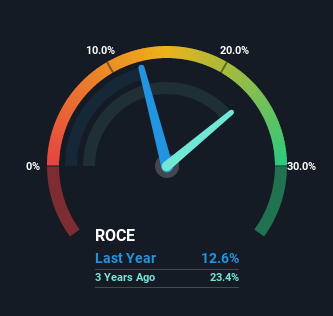Capital Allocation Trends At JB Foods (SGX:BEW) Aren't Ideal
What trends should we look for it we want to identify stocks that can multiply in value over the long term? Ideally, a business will show two trends; firstly a growing return on capital employed (ROCE) and secondly, an increasing amount of capital employed. Put simply, these types of businesses are compounding machines, meaning they are continually reinvesting their earnings at ever-higher rates of return. However, after briefly looking over the numbers, we don't think JB Foods (SGX:BEW) has the makings of a multi-bagger going forward, but let's have a look at why that may be.
Understanding Return On Capital Employed (ROCE)
If you haven't worked with ROCE before, it measures the 'return' (pre-tax profit) a company generates from capital employed in its business. The formula for this calculation on JB Foods is:
Return on Capital Employed = Earnings Before Interest and Tax (EBIT) ÷ (Total Assets - Current Liabilities)
0.13 = US$27m ÷ (US$471m - US$258m) (Based on the trailing twelve months to December 2022).
Therefore, JB Foods has an ROCE of 13%. In absolute terms, that's a pretty normal return, and it's somewhat close to the Food industry average of 12%.
See our latest analysis for JB Foods
While the past is not representative of the future, it can be helpful to know how a company has performed historically, which is why we have this chart above. If you want to delve into the historical earnings, revenue and cash flow of JB Foods, check out these free graphs here.
What The Trend Of ROCE Can Tell Us
On the surface, the trend of ROCE at JB Foods doesn't inspire confidence. To be more specific, ROCE has fallen from 24% over the last five years. Although, given both revenue and the amount of assets employed in the business have increased, it could suggest the company is investing in growth, and the extra capital has led to a short-term reduction in ROCE. If these investments prove successful, this can bode very well for long term stock performance.
Another thing to note, JB Foods has a high ratio of current liabilities to total assets of 55%. This can bring about some risks because the company is basically operating with a rather large reliance on its suppliers or other sorts of short-term creditors. While it's not necessarily a bad thing, it can be beneficial if this ratio is lower.
In Conclusion...
In summary, despite lower returns in the short term, we're encouraged to see that JB Foods is reinvesting for growth and has higher sales as a result. In light of this, the stock has only gained 5.2% over the last five years. Therefore we'd recommend looking further into this stock to confirm if it has the makings of a good investment.
JB Foods does have some risks, we noticed 4 warning signs (and 2 which shouldn't be ignored) we think you should know about.
For those who like to invest in solid companies, check out this free list of companies with solid balance sheets and high returns on equity.
Have feedback on this article? Concerned about the content? Get in touch with us directly. Alternatively, email editorial-team (at) simplywallst.com.
This article by Simply Wall St is general in nature. We provide commentary based on historical data and analyst forecasts only using an unbiased methodology and our articles are not intended to be financial advice. It does not constitute a recommendation to buy or sell any stock, and does not take account of your objectives, or your financial situation. We aim to bring you long-term focused analysis driven by fundamental data. Note that our analysis may not factor in the latest price-sensitive company announcements or qualitative material. Simply Wall St has no position in any stocks mentioned.
Join A Paid User Research Session
You’ll receive a US$30 Amazon Gift card for 1 hour of your time while helping us build better investing tools for the individual investors like yourself. Sign up here

